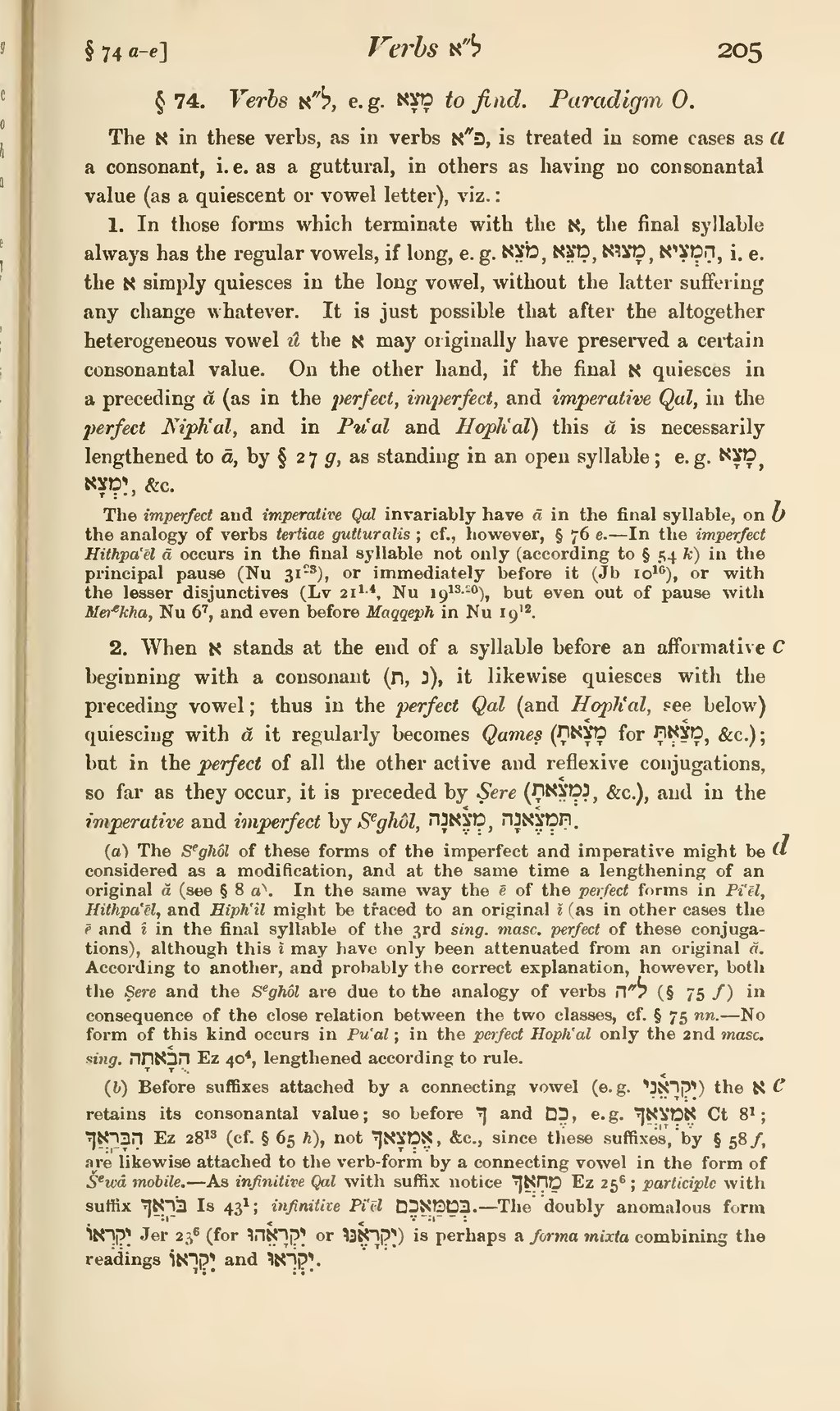[a] The א in these verbs, as in verbs פ״א, is treated in some cases as a consonant, i.e. as a guttural, in others as having no consonantal value (as a quiescent or vowel letter), viz.:
1. In those forms which terminate with the א, the final syllable always has the regular vowels, if long, e.g. מֹצֵא, מִצֵּא, מָצוּא, הִמְצִיא, i.e. the א simply quiesces in the long vowel, without the latter suffering any change whatever. It is just possible that after the altogether heterogeneous vowel û the א may originally have preserved a certain consonantal value. On the other band, if the final א quiesces in a preceding ă (as in the perfect, imperfect, and imperative Qal, in the perfect Niphʿal, and in Puʿal and Hophʿal) this ă is necessarily lengthened to ā, by § 27 g, as standing in an open syllable; e.g. מָצָא, יִמְצָא, &c.
[b] The imperfect and imperative Qal invariably have ā in the final syllable, on the analogy of verbs tertiae gutturalis; cf., however, § 76 e.—In the imperfect Hithpaʿēl ā occurs in the final syllable not only (according to § 54 k) in the principal pause (Nu 3123), or immediately before it (Jb 1016), or with the lesser disjunctives (Lv 211.4, Nu 1913.20), but even out of pause with Merekha, Nu 67, and even before Maqqeph in Nu 1912.
[c] 2. When א stands at the end of a syllable before an afformative beginning with a consonant (ת, נ), it likewise quiesces with the preceding vowel; thus in the perfect Qal (and Hophʿal, see below) quiescing with ă it regularly becomes Qumeṣ (מָצָ֫אתָ for מָצַ֫אְתָּ, &c.); but in the perfect of all the other active and reflexive conjugations, so far as they occur, it is preceded by S̥̥ere (נִמְצֵ֫אתָ, &c.), and in the imperative and imperfect by Seghôl, מְצֶ֫אנָה, תִּמְצֶאנָה.
[d] (a) The Seghôl of these forms of the imperfect and imperative might be considered as a modification, and at the same time a lengthening of an original ă (see § 8 a). In the same way the ē of the perfect forms in Piʿēl, Hithpaʿēl, and Hiphʿîl might be traced to an original ĭ (as in other cases the ē and î in the final syllable of the 3rd sing. muse. perfect of these conjugations), although this ĭ may have only been attenuated from an original ă. According to another, and probably the correct explanation, however, both the Ṣere and the Seghôl are due to the analogy of verbs ל״ה (§ 75 f) in consequence of the close relation between the two classes, cf. § 75 nn.—No form of this kind occurs in Puʿal; in the perfect Hophʿal only the 2nd masc. sing. הֻבָ֫אתָה Ez 404, lengthened according to rule.
[e] (b) Before suffixes attached by a connecting vowel (e.g. יִקְרָאֵ֫נִי) the א retains its consonantal value; so before ךָ and בֶם, e.g. אֶמְצָֽאֲךָ Ct 81; הִבָּרַֽאֲךָ Ez 2813 (cf. § 65 h), not אֶמְצָאךָ, &c., since these suffixes, by § 58 f, are likewise attached to the verb-form by a connecting vowel in the form of Šewâ mobile.—As infinitive Qal with suffix notice מַחְאֲךָ Ez 256; participle with suffix בֹּדַֽאֲךָ Is 431; infinitive Piʿēl בְּטַמַּֽאֲכֶם.—The doubly anomalous form יִקְרְאוֹ Jer 236 (for יִקְרָאֵ֫הוּ or יִקְרָאֶ֫נּוּ) is perhaps a forma mixta combining the readings יִקְרָאוֹ and יִקְרְאוּ.
